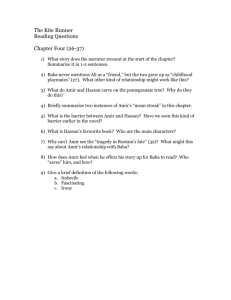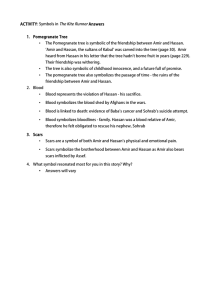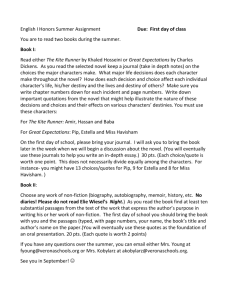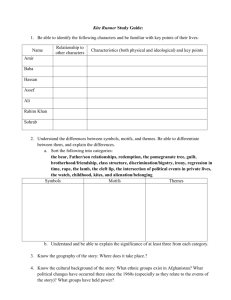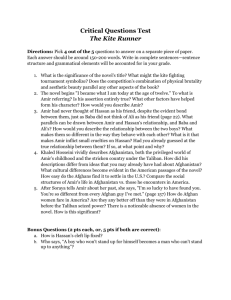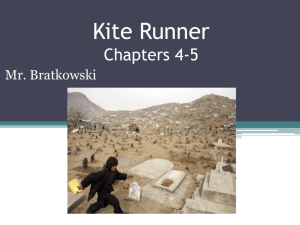Andrews Madison Andrews Dr. Beach Honors English 10 16
advertisement
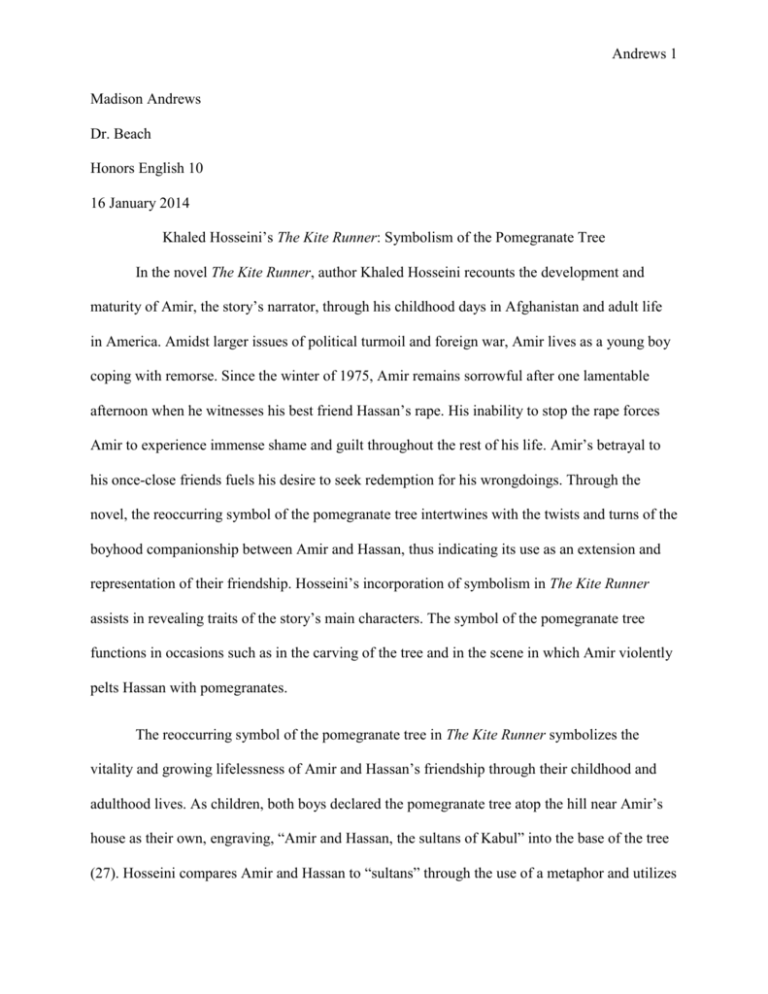
Andrews 1 Madison Andrews Dr. Beach Honors English 10 16 January 2014 Khaled Hosseini’s The Kite Runner: Symbolism of the Pomegranate Tree In the novel The Kite Runner, author Khaled Hosseini recounts the development and maturity of Amir, the story’s narrator, through his childhood days in Afghanistan and adult life in America. Amidst larger issues of political turmoil and foreign war, Amir lives as a young boy coping with remorse. Since the winter of 1975, Amir remains sorrowful after one lamentable afternoon when he witnesses his best friend Hassan’s rape. His inability to stop the rape forces Amir to experience immense shame and guilt throughout the rest of his life. Amir’s betrayal to his once-close friends fuels his desire to seek redemption for his wrongdoings. Through the novel, the reoccurring symbol of the pomegranate tree intertwines with the twists and turns of the boyhood companionship between Amir and Hassan, thus indicating its use as an extension and representation of their friendship. Hosseini’s incorporation of symbolism in The Kite Runner assists in revealing traits of the story’s main characters. The symbol of the pomegranate tree functions in occasions such as in the carving of the tree and in the scene in which Amir violently pelts Hassan with pomegranates. The reoccurring symbol of the pomegranate tree in The Kite Runner symbolizes the vitality and growing lifelessness of Amir and Hassan’s friendship through their childhood and adulthood lives. As children, both boys declared the pomegranate tree atop the hill near Amir’s house as their own, engraving, “Amir and Hassan, the sultans of Kabul” into the base of the tree (27). Hosseini compares Amir and Hassan to “sultans” through the use of a metaphor and utilizes Andrews 2 the symbolic diction of “sultan” to emphasize its connotation of strength and stability. By comparing the two boys to “sultans,” Hosseini bonds the boys’ friendship to the meaning of the word, thus implying their companionship as stable and unwavering. Although seemingly secure, Amir and Hassan’s relationship takes an immediate downfall after Hassan’s rape, Amir’s avoidance, and their ultimate divergence. Interestingly, after all prior events, the once-beloved tree dies, further suggesting its synonymy with the boy’s friendship. Additionally, when returning to Afghanistan, Amir visits the tree for the first time since his departure decades earlier and notices that “the pomegranate tree hadn’t borne fruit in years” (276). The suggestive diction of “hadn’t borne fruit” corresponds with and symbolically implies the decline in Amir and Hassan’s relationship. Amir reiterates that the once blooming tree transformed into “wilted, leafless” plant, and could possibly never produce fruits once enjoyed, again hinting to the end of a friendship beyond repair (264). Although both Hassan and the tree pass, the carving, though weathered and “almost faded” still remains (264). The carving lasts as a permanent connection between Amir and Hassan, exemplifying how although the friendship has faltered, they still remain connected even through death. By Hosseini’s use of symbolism, the audience recognizes how a once-thriving companionship converts into a distancing relationship between the two old friends. During the apex of Amir and Hassan’s relationship, the pomegranate tree exhibits significant character traits of both boys. Amir, when under the pomegranate tree, unexpectedly questions and torments Hassan, interrogating, “ ‘What would you do if I hit you with this [pomegranate]?’ ”(91). The caustic diction of “what would you do” evokes a mocking tone, indirectly characterizing Amir as dominant, taunting, and ridiculing towards Hassan. Contrastingly, Hosseini distinguishes the difference between the personalities of Amir and Andrews 3 Hassan, and indirectly characterizes Hassan’s overall personality as despondent and allowing, while also revealing him as tolerant to Amir’s dejection and condescension. When not receiving a reply to his question, Amir strikes Hassan in the chest by “hurling the pomegranate” at him (91). The harsh diction of “hurling” epitomizes Amir’s callous tone and indirectly exhibits his malicious, hurtful nature. When Hassan does not pelt Amir with pomegranates, Amir cries, “ ‘Hit me back!...Get up! Hit me!’ ” (92). Amir’s repetition of the phrase “hit me” and his repeating exclamation depict his severe desperation for punishment. Amir’s yearning for reprimand stems not only from just hurting Hassan, but for abandoning him earlier in his time of need earlier during his rape. His inability to battle his inner guilt provokes him to torment Hassan in order to earn punishment. Instead of matching Amir’s hostility, Hassan hits a pomegranate “against his own forehead” (93). Hosseini again reiterates Hassan’s passivity but emphasizes the fact that Hassan would rather hurt himself than Amir. Here, the use of pomegranates help to imply certain character traits to Amir and Hassan, and the symbolism of pomegranates mocks the condition of their friendship. Substantially, the pomegranate and the emotions of Amir “exploded,” leaving only the ruins of the once-fruitful companionship to remain. Their relationship, now in shambles, coincidentally mimics the condition of the pomegranates after the pelting: damaged and shattered. Through Hosseini’s incorporation of symbolism, the audience observes both the character traits of Amir and Hassan and the transformation of their relationship. The use of the pomegranate tree as a symbol reiterates the contrasting personalities of Amir and his best friend Hassan. Using Amir as an example, Khaled Hosseini writes to those living with guilt to differentiate between correct and incorrect ways to manage such issues. Instead of resorting to physical violence as Amir does, Hosseini encourages reconciliation through peaceful negotiation. In addition, Hosseini also writes to those who have lost a close Andrews 4 friend to relate and empathize with others in similar situations. Hosseini reiterates commonality of the relationship between Amir and Hassan to those between readers and their own loved ones. Hosseini actively exhibits a message that relates to both Amir and readers: although the bonds between two friends may break and fade away, “a kinship that time could not break” can still remain even after parting (11).
